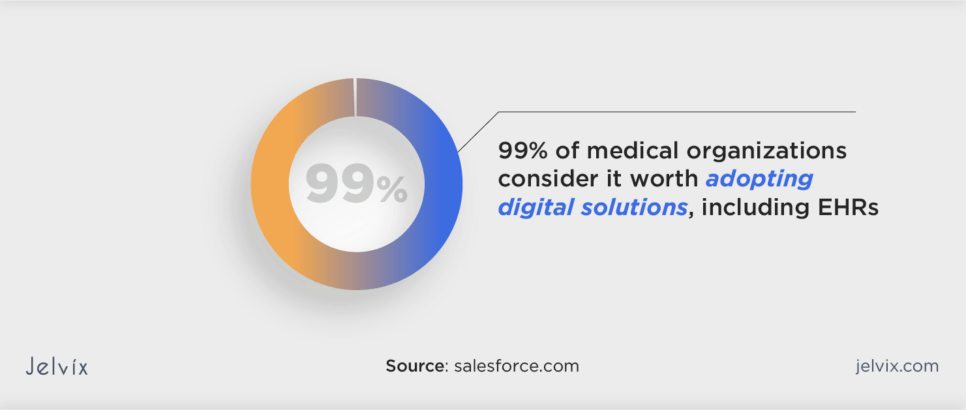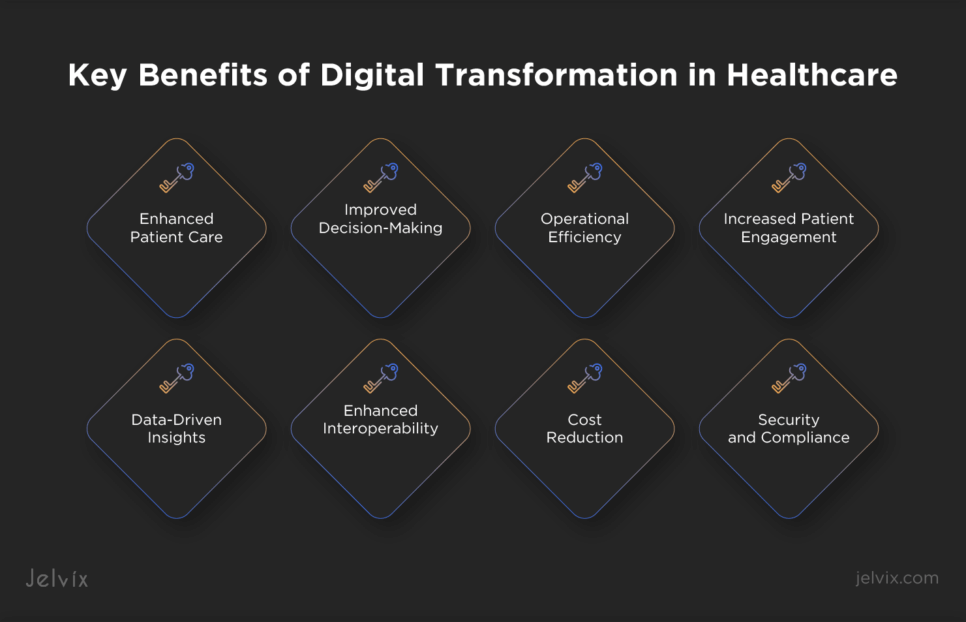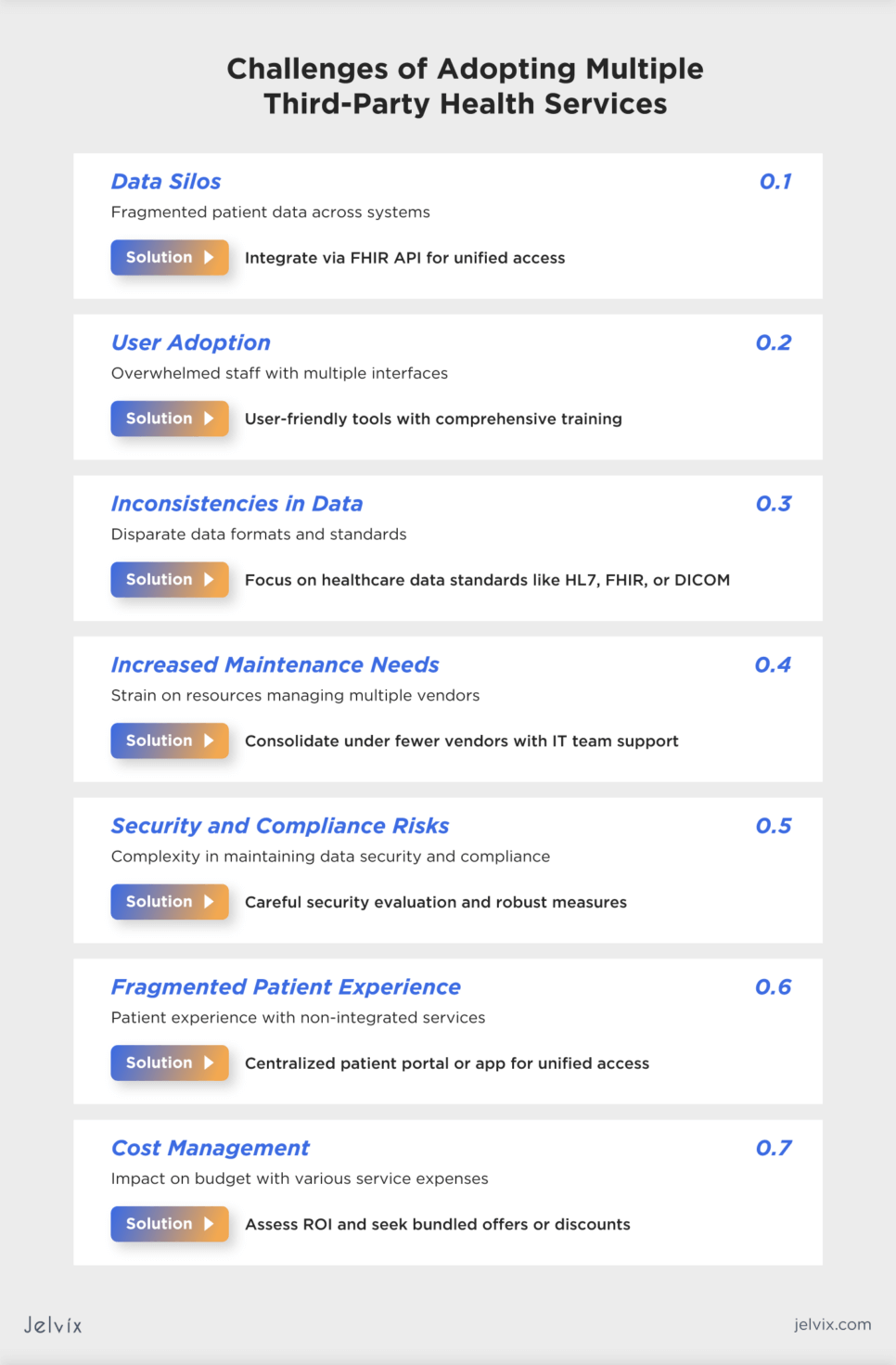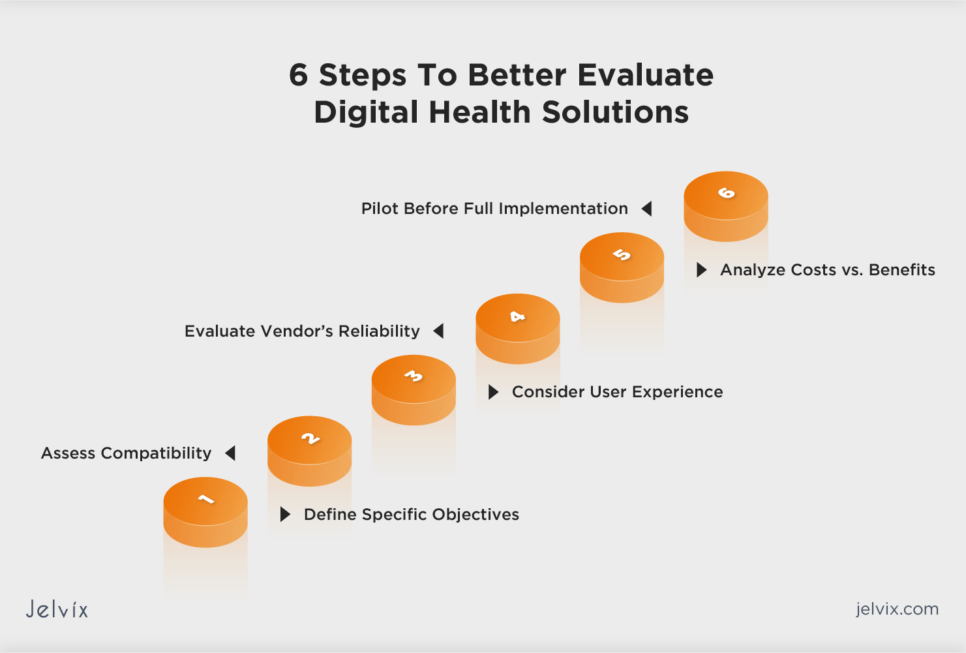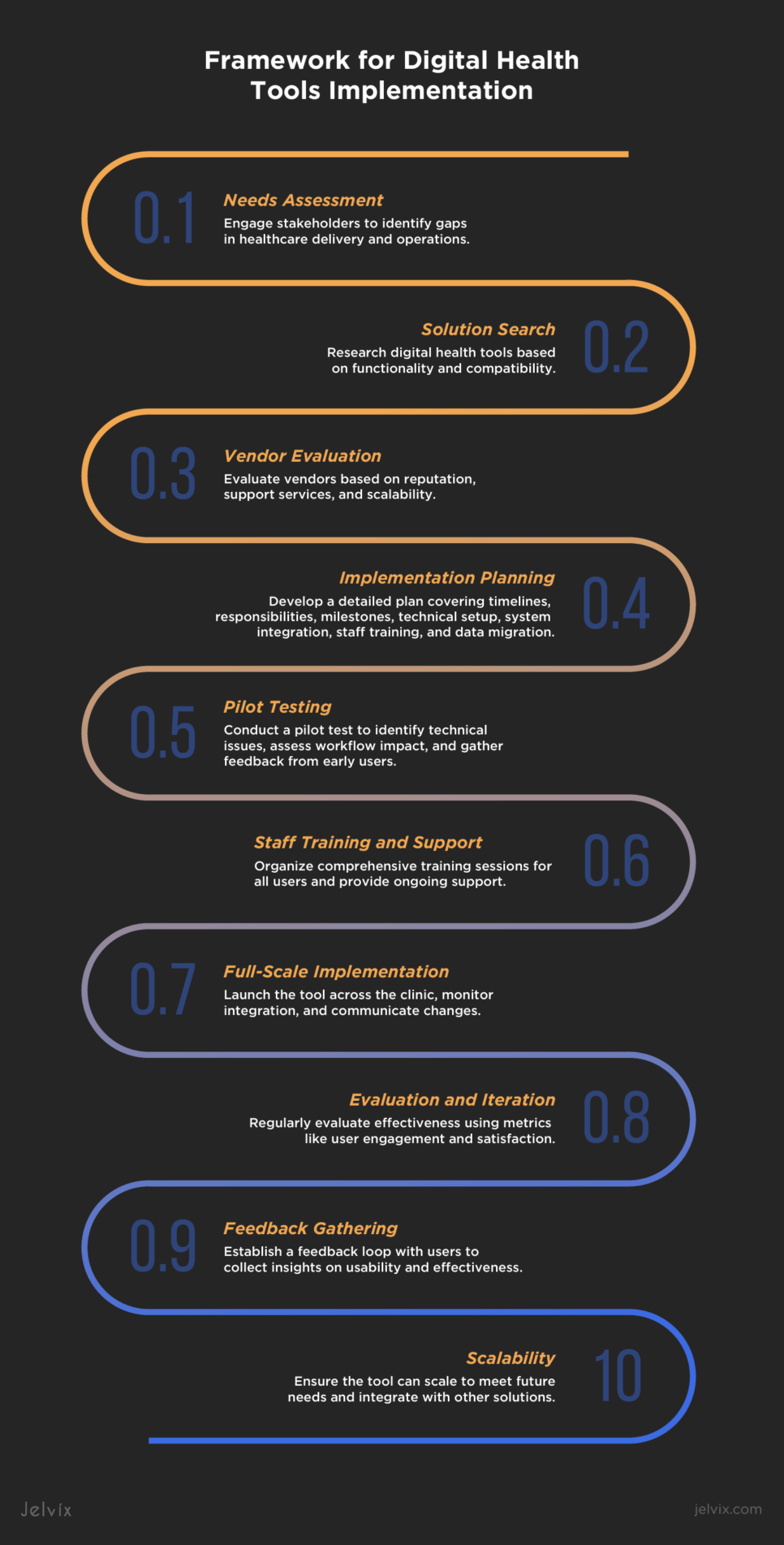A significant trend toward digitalization is seen in healthcare now. Salesforce reports that about 99% of medical organizations consider it worth adopting digital solutions, including EHRs, with 18 new hospitals having opted for Epic in 2023.
Although digital tools can bring numerous benefits to healthcare facilities, adopting these tools can be challenging, especially if you are not exactly sure what you need. What’s more, integrating them requires technical and legal expertise that providers often don’t possess.
If you struggle to comb through countless healthcare tech options and are unsure which digital solution suits your business best, read this article. You’ll find out how to avoid unnecessary expenditures on technology that you don’t need and invest in solutions that will increase your return on investment.
Key Benefits of Digital Transformation in Healthcare
Various healthcare researches indicate that digital tools, with their personalized care approach, can greatly contribute to increasing patient engagement. It means that efficiently combing through available healthcare solutions and choosing the right one can move your clinic toward an integrated, technology-driven, and insightful care delivery.
Enhanced Patient Care
Digital tools equip physicians with immediate access to patient information, assisting them in making informed decisions and creating personalized care plans. For instance, telehealth services break the barriers of traditional care, offering patients the possibility to receive medical advice from the comfort of their homes.
Improved Decision-Making
Using the power of big data analytics and AI-driven diagnostics, medical professionals can get valuable health insights, predict health outcomes more precisely, and quickly determine the most effective treatment options.
Operational Efficiency
The automation of administrative tasks, including appointment setting, patient check-in, and billing, minimizes manual workload on staff and reduces the chance of errors. Digital solutions bring order to operations, freeing up healthcare staff to dedicate more time to patient care.
Increased Patient Engagement
Digital platforms empower patients to take an active role in their treatment processes. Through patient portals and mobile apps, they can review their medical history, communicate with physicians, and take charge of their health with greater ease.
Data-Driven Insights
Analyzing healthcare data allows for a clearer approach to care, population health management, and medical research. This enables medical pros to observe trends, assess the impact of health interventions, and base their decisions on solid data.
Enhanced Interoperability
Digital tools in healthcare encourage interoperability across various medical systems, ensuring smooth data exchange. This unified access to patient data allows healthcare teams to view the updated patient info from anywhere and anytime.
Cost Reduction
By optimizing operations and reducing inefficiencies, digital transformation can significantly lower healthcare costs. For example, technologies for virtual care can decrease the need for in-person visits, reducing expenses for both healthcare facilities and patients.
Security and Compliance
Designed with strict security protocols, digital health technologies safeguard sensitive patient information, adhering to regulatory standards like HIPAA in the U.S. and GDPR in the EU, helping providers earn trust among patients.
Adopting Multiple Third-Party Health Services: Common Challenges
Adopting multiple third-party digital services that offer advanced functionalities can significantly enhance workflows and improve patient care. However, integrating these services into an already established system can present challenges. Failing to address them can disrupt workflows, so make sure to recognize and manage each challenge before you go into digital transformation in healthcare.
Data Silos
Fragmented patient data across different systems can limit care coordination. Integrating third-party services through a FHIR API can help ensure all patient information is available in one place so that physicians can access it anytime for informed decision-making.
User Adoption
The introduction of multiple interfaces and processes can overwhelm staff. Opt for user-friendly services and tools that offer intuitive interfaces. A unified dashboard for accessing various services can simplify the user experience for your physicians. Also, make sure to provide comprehensive training on using new tools for your healthcare teams.
Inconsistencies in Data
Disparate data formats and standards may lead to critical medical errors. Focus on services that use healthcare data standards like HL7, FHIR, or DICOM to support interoperability and facilitate data exchange across disparate systems.
Increased Maintenance Needs
Managing services from multiple vendors can strain resources. Consolidate these services under fewer vendors and select those providing adequate support and maintenance. Consider gathering an IT team for vendor management to organize support and maintenance processes.
Security and Compliance Risks
The integration of numerous services raises the complexity of maintaining data security and meeting healthcare regulations. Perform careful security evaluation for each service, ensuring compliance with standards such as HIPAA and GDPR, and implement robust security measures alongside regular audits.
Fragmented Patient Experience
Patients may face a confusing and disjointed experience when services are not well-integrated. To avoid this, use a centralized patient portal or app that brings together key features like scheduling appointments, communicating with providers, and accessing health records. This unified approach will help ensure a consistent patient experience across all digital interactions.
Cost Management
The total expense of incorporating various services can significantly affect your healthcare entity’s budget. Assess the return on investment carefully by considering both the direct advantages and hidden costs. Seek out bundled offers or discounts from vendors for using multiple services, as this can help you save funds.
Best Practices for Recognizing Gaps in Your Current Digital Care Solutions
To support smart growth at your clinic, you need to learn to identify gaps in existing healthcare solutions. Addressing these gaps will help you enhance patient care, organize operations efficiently, and ensure your technology investment delivers the best value.
Conduct a Digital Audit
Begin with a review of your current digital infrastructure. Examine the technologies in use, from EHRs to patient engagement platforms, and assess their performance, integration capabilities, and user satisfaction levels. This audit will give you an understanding of what performs well and what needs improvement.
Gather User Feedback
Feedback is invaluable in understanding the effectiveness of your digital tools. Engage with staff and patients to gather insights into their experiences, challenges, and needs. Staff feedback can reveal operational bottlenecks and usability issues, while patient feedback can spotlight areas for enhancing the care experience.
Analyze Workflows and Processes
Evaluate your clinical and administrative workflows in detail. Look for processes that rely heavily on manual tasks, are sensitive to errors, or cause delays in patient care. Identifying these processes can reveal opportunities to automate tasks, improve accuracy, and save time.
Benchmark Against Industry Standards
Benchmarking can help identify areas where your clinic may be failing and opportunities for adopting new technologies. Compare your digital capabilities with industry standards and best practices. Look at how similar clinics are using technology to improve care delivery, patient engagement, and operational efficiency.
Review Data Accessibility and Integration
Assess how easily and effectively your staff can access and share patient data across different systems. Gaps in data accessibility and integration can compromise coordinated care and decision-making.
Identify Unadressed Needs
Through your audit, feedback collection, and analysis, compile a list of unmet needs within your entity. For instance, BMC reports that unmet healthcare needs for older patients happen primarily due to the high cost of care, lack of clinics, and scheduling conflicts. You could address this gap by implementing virtual consultations tailored for the aging population, helping patients to receive care anytime and with less resources spent.
With a clear understanding of where gaps exist, prioritize them based on their impact on patient care and clinical operations. Develop a comprehensive plan for addressing these gaps, taking into account factors like budget, available resources, and potential ROI.
6 Steps To Better Evaluate Digital Health Solutions
Evaluating digital health solutions requires a methodical approach to ensure that the technology aligns with your clinic’s needs, enhances patient care, and integrates seamlessly into existing workflows. The Jelvix team recommends that you follow a step-by-step approach to successfully conduct this process.
1. Define Specific Objectives
Clearly outline what you aim to achieve with digital health solutions. Whether it’s improving patient engagement, making administrative processes more efficient, or enhancing clinical decision-making, having clear objectives will help focus on solutions that meet your specific needs.
2. Assess Compatibility
Evaluate how well the chosen solutions integrate with your existing healthcare systems, such as EHRs and practice management tools. Seamless integration is critical for avoiding data silos and ensuring smooth workflows. Compatibility with current hardware and software infrastructure will support clinical interoperability and help minimize additional investments.
3. Consider User Experience
Analyze a selected solution’s user experience to ensure it is easy to use for both healthcare pros and patients. The solution should be intuitive and simple to encourage adoption and maximize its benefits. Consider conducting a usability test or demo to get a firsthand look at the solution’s interface and functionality. Also, ensure it supports Web Content Accessibility Guidelines (WCAG) to make care accessible to everyone regardless of their physical abilities and digital literacy.
4. Evaluate Vendor’s Reliability
Research the provider’s reputation for customer support and service reliability. Comprehensive vendor support is vital for addressing issues swiftly and ensuring the continuous and smooth operation of the selected digital health solution. Look for reviews, testimonials, and case studies from existing clients.
5. Analyze Costs vs. Benefits
Conduct a cost-benefit analysis that includes initial purchase, implementation costs, and ongoing expenses such as subscriptions, maintenance, and training. Compare these costs against the expected benefits, including operational efficiencies, improved patient outcomes, and potential revenue growth.
6. Pilot Before Full Implementation
Before committing to a full rollout, conduct a test launch of the solution in a limited scope to evaluate its impact on your clinic’s operations and patient care. A pilot allows you to identify any unforeseen challenges and assess the solution’s real-world applicability and effectiveness.
Navigate the complex process of choosing a health tech partner with Jelvix's comprehensive guide. Find essential criteria and expert insights for successful collaborations in healthcare.
Using Gamification and Feedback Loops To Maximize Engagement from an All-In-One Management Solution
Incorporating gamification and feedback loops into your management solutions can significantly enhance digital patient engagement. Gamification elements like challenges and rewards can motivate patients to actively participate in their health. At the same time, feedback loops help ensure continuous improvement by capturing patient insights and experiences, allowing your clinic to adapt and refine its offerings.
Implement Gamification Strategies
Gamification involves adding game-like elements into non-game environments, such as healthcare management, to motivate and engage users.
Health Challenges and Goals
Implement features that allow patients to set health-related goals and track their progress. Encourage participation through challenges that can be completed for achievement badges.
Reward System
Create a reward system for completing health assessments, attending scheduled appointments, or participating in preventive care programs. Rewards can include discounts, special offers, or points that patients can redeem for services.
Educational Games
Incorporate educational content in a game format to engage patients in learning about their health conditions, treatment plans, and healthy lifestyle choices. This can help educate them about complex conditions in a positive and interactive way.
Establish Feedback Loops
Feedback loops are mechanisms that allow for continuous communication between patients and physicians.
Patient Surveys and Feedback Tools
Include easy-to-use tools for patients to provide feedback on their experiences, treatment outcomes, and satisfaction levels. This direct line of communication will allow you to gather valuable insights and use them for improvements.
Real-Time Responses
Develop a system for promptly addressing feedback, whether it’s resolving concerns or acknowledging positive reviews. This will show patients that their opinions are valued and acted upon, enhancing their trust and loyalty.
Personalization
Use feedback to personalize patient experiences. For example, if patients express interest in more information about a specific health topic, the system can recommend related educational content or services.
You can use the data collected from gamification and feedback features to analyze patient engagement levels, identify health trends, and understand patient preferences. This data-driven approach will enable your clinic to continuously refine its engagement strategies.
Framework for Digital Health Tools Implementation
Implementing digital health tools in your clinic involves a series of steps to ensure that the integration supports clinical goals, enhances patient care, and optimizes operational efficiency. A well-defined framework can guide clinics through the complex process of selecting, implementing, and maximizing the benefits of digital health solutions.
The Jelvix team recommends following a step-by-step approach to smoothly integrate digital solutions of your choice into established clinical settings.
1. Needs Assessment
Conduct a needs assessment to identify gaps in your current healthcare delivery and operational processes that digital tools could address. Engage stakeholders, including clinicians, administrative staff, and patients, to understand their needs and expectations.
2. Solution Search
Research available digital health tools that align with the identified needs. Consider factors like functionality, compatibility with existing systems, user-friendliness, and compliance with healthcare regulations. Shortlist solutions that best match your clinic’s requirements.
3. Vendor Evaluation
Evaluate potential vendors based on their reputation, support services, cost-effectiveness, and the scalability of their solutions. Choose a vendor that offers suitable products and provides reliable customer support and training.
4. Implementation Planning
Develop a detailed implementation plan that includes timelines, responsibilities, and milestones. The plan should cover all aspects of the implementation process, from technical setup and system integration to staff training and data migration.
5. Pilot Testing
Conduct a pilot test of the chosen digital health tool in a controlled environment or with a small user group. This will help you to identify possible technical issues, assess the tool’s impact on workflows, and gather feedback from early users.
6. Staff Training and Support
Organize comprehensive training sessions for all users, ensuring they are comfortable with the new digital tool. Provide ongoing support to address any questions or issues that may arise.
7. Full-Scale Implementation
Launch the digital health tool across your clinic, closely monitoring the implementation process to ensure smooth integration into existing workflows. Communicate openly with the staff and patients about the changes and how they can benefit from the new tool.
8. Evaluation and Iteration
Regularly evaluate the effectiveness of the digital health tool against your business objectives. Use metrics like user engagement, patient satisfaction, and operational efficiency to measure success. Be prepared to make iterative improvements based on feedback and performance analysis.
9. Feedback Gathering
Establish a continuous feedback loop with users to collect insights on the tool’s usability and effectiveness. Use this feedback to refine and optimize the solution over time.
10. Scalability
Ensure the digital health solution can scale to meet future growth and adapt to changing medical trends. This includes assessing the tool’s ability to integrate with other digital health solutions and support arising healthcare needs.
How Jelvix Can Assist in Healthcare Digital Transformation
By carefully selecting digital health solutions, addressing integration challenges, identifying and filling gaps in current digital offerings, and engaging patients through innovative platforms, healthcare entities can achieve smarter digital growth, increase patient engagement, and save operational costs.
If you’re aiming to boost your healthcare business efficiency by using digital health solutions but struggling to do it independently, the Jelvix team can provide you with assistance. Contact our experts for help in choosing the right healthcare solution or guidance on developing a unique tool based on your needs from scratch.
Need a qualified team?
Extend your development capacity with the dedicated team of professionals.


